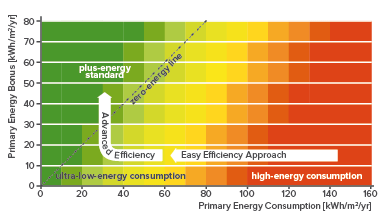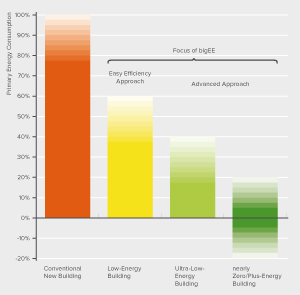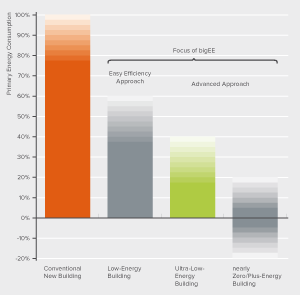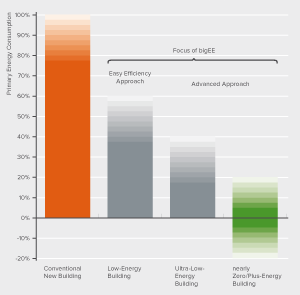A Strategic Approach to integrated building design is the key to achieving high-energy savings at low or no extra cost in residential buildings.
bigEE recommends using this Strategic Approach for energy efficiency in buildings. Although it includes an Easy-Efficiency Approach as well as an Advanced-Efficiency Approach the first step will not be sufficient to reach long-term climate protection goals. It is thus necessary to implement and support an Advanced Approach at the earliest to avoid lock-in effects. This would otherwise result in less efficient houses than achievable continuing in use for decades because of long building lifetimes.

Overview – New residential buildingsThe Strategic Approach follows a holistic design process with the premise of first implementing passive options for building design and then implementing the active options as need arises to provide thermal comfort. These systems then need to be controlled intelligently through automation and informed user behaviour to reach maximum optimization. In the short-term, the Easy-Efficiency Approach should be implemented at minimum. It focuses on low-cost options, mainly passive options. Improving energy efficiency by implementing the Easy-Efficiency Approach can reduce primary energy consumption for cooling, heating, ventilation and domestic hot water by 40 to 60 % to achieve a Low-Energy Building (LEB). Implementing the advanced approach can reduce primary energy consumption by up to 90 % to achieve an Ultra-Low- Energy Building (ULEB). Further improvements, especially through the use of renewable energy technologies can reduce the primary energy consumption by nearly 100 % or even beyond achieving (nearly) Zero-Energy Buildings (nZEB) to being net energy producer Plus-Energy Buildings (PEB). |
|

Low-Energy Buildings - New residential buildingsThe Easy-Efficiency Approach or Low-Energy Building (LEB) is characterised by an intelligent (holistic/integrated) building design in combination with an appropriate choice of efficient technologies for heating, cooling, hot water production, lighting etc. By fulfilling basic rules of energy-efficient design especially passive options, any incremental capital costs incurred are compensated by energy cost savings within a few years and certainly provide returns over the lifetime of the buildings. Thus the most important advantage of these buildings is that they are - as a rule - economically attractive over their lifetime as they make use of the ‘low hanging fruits’ of energy efficiency options. |
|

| Energy saving potential of 40 to 60 % |
| Low or no extra capital costs |
| Lower lifetime costs |
| Increased thermal comfort |
| Enhanced indoor air quality |
Ultra-Low-Energy Buildings - New residential buildingsThe Advanced-Efficiency Approach or Ultra-Low-Energy Buildings (ULEB) is a further development of a Low-Energy Building, requiring up to 90 % less primary energy consumption than a conventional new building. The Ultra-Low-Energy Building maximizes a building’s energy efficiency potential. An Advanced-Efficiency Approach is needed to attain these low levels of energy consumption. Ultra-Low-Energy Buildings set more ambitious energy efficiency standards, using the most-energy-efficient components and systems available to reduce the energy consumption. This energy consumption should preferably be covered by renewable energy sources such as solar energy, ambient and geothermal energy, sustainable biomass etc. It can be cost-effective, depending on the trade-off between incremental capital costs and long-term energy cost savings but this may not always be the case. |
|

| Energy saving potential of 60 to at least 80 % (and in many cases up to 90%) |
| High levels of insulation |
| Slightly higher or low extra capital costs |
| Lower utility costs |
| Lower lifetime costs |
| Increased thermal comfort |
| Enhanced indoor air quality |
(nearly) Zero and Plus-Energy Buildings - New residential buildingsThe (nearly) Zero-Energy Building (nZEB) and the Plus-Energy Building (PEB) concepts are based on the Low-Energy Building or preferably the Ultra-Low-Energy Building concept described in the Strategic Approach. This building standard requires on-site energy generation from renewable energy sources or the use of Combined Heat and Power (CHP) systems in addition to an already high energy-efficient building. As on-site generation is normally more expensive the best possible measure is to minimize energy consumption. If the amount of on-site produced energy (converted in primary energy equivalent) is roughly equal to the annual primary energy consumption, the building can be described as a (nearly) Zero-Energy Building. If energy production exceeds the consumption, the term Plus-Energy Building will be used. |
|

| Energy saving potential of up to and over 100% respectively |
| High levels of insulation |
| Slightly higher extra capital costst |
| Lower utility costs |
| Lower lifetime costs |
| Increased thermal comfort |
| Better indoor air quality |
| Renewable energy to cover energy consumption |